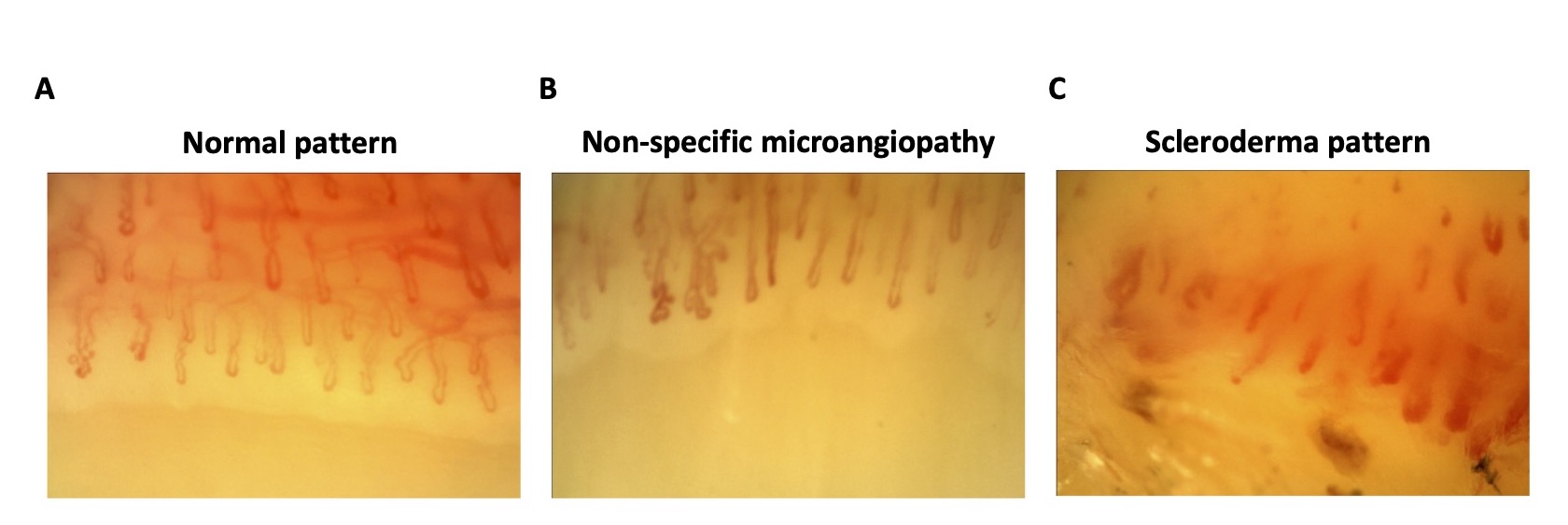Session Information
Date: Saturday, November 6, 2021
Title: Systemic Sclerosis & Related Disorders – Clinical Poster I (0387–0413)
Session Type: Poster Session A
Session Time: 8:30AM-10:30AM
Background/Purpose: Mixed connective tissue disease (MCTD) is a rare autoimmune condition characterized by Raynaud’s phenomenon, positivity of antibodies targeting the U1 small nuclear ribonucleoprotein particle (U1 snRNP), various clinical features and potential risk of severe cardio-pulmonary involvement (interstitial lung disease, ILD, and pulmonary hypertension, PH).
Nailfold videocapillaroscopy (NVC) is a simple, non-invasive and inexpensive imaging technique that allows a detailed assessment of skin microcirculation. NVC abnormalities have been barely described in MCTD and associations between NVC features and MCTD disease characteristics have only been partially investigated. Our objective was to describe the NVC patterns observed in MCTD and assess their potential association with disease characteristics.
Methods: Cross-sectional study based on the retrospective analysis of patients hospitalized in the department of Rheumatology, Cochin Hospital, Paris France. To be included, patients were required to fulfill at least one classification criteria used in MCTD. The following data were collected: demographics, clinical features, para-clinical and laboratory data, treatment, and NVC findings.
Results: 51 patients met the inclusion criteria. Mean age was 51±12 years, 44 (86%) were women, mean disease duration was 13.8±11.1 years and 16 patients (31%) had ILD. Three different NVC patterns have been identified in our cohort: a) normal findings in 6 patients (11,7 %) (Figure 1A); b) non-specific organic microangiopathy in 16 patients (31,4%) (Figure 1B) and c) scleroderma pattern in 18 patients (35.3%) (Figure 1C), defined by the presence of at least 3 of the 4 following features: at least 1 giant capillary, decreased capillary density (< 7/mm), avascular areas and disorganization of capillary bed architecture (4). Scleroderma pattern was associated with clinical features of systemic sclerosis: skin sclerosis (9/18 vs. 5/33; p=0.008) and digital ulcers (6/18 vs. 2/31; p=0.017). Conversely, no association was observed between the normal or the non-specific NVC pattern and disease specific characteristics. Interestingly, we observed a significant reduction in the number of capillaries in patients with ILD (4.80±1.87 vs. 6.03±1.47; p=0.039), and patients with severe reduction of capillary density (≤4/mm) were more likely to have ILD (5/7 vs. 5/33; p=0.002). Neoangiogenesis was also more frequent in patients with ILD (6/13 vs. 4/27; p=0.034). Multivariate logistic regression analysis showed that the association between severe reduction of capillary density and ILD was observed independently of the presence of a scleroderma NVC pattern and skin fibrosis.
Conclusion: We identified three main NVC patterns in MCTD patients. The scleroderma NVC pattern was associated with clinical scleroderma characteristics whereas non-specific microangiopathy and normal NVC were not associated with a specific phenotype. Moreover, severe capillary loss was independently associated with the presence of ILD. These data suggest that NVC may be helpful for disease risk stratification in MCTD, and that NVC findings, and particularly severe capillary loss, may be a warning for the presence of ILD.
To cite this abstract in AMA style:
Kasser C, Boleto G, Allanore Y, Avouac J. Nailfold Videocapillaroscopy Findings and Associations with Organ Involvement in Mixed Connective Tissue Disease [abstract]. Arthritis Rheumatol. 2021; 73 (suppl 9). https://acrabstracts.org/abstract/nailfold-videocapillaroscopy-findings-and-associations-with-organ-involvement-in-mixed-connective-tissue-disease/. Accessed .« Back to ACR Convergence 2021
ACR Meeting Abstracts - https://acrabstracts.org/abstract/nailfold-videocapillaroscopy-findings-and-associations-with-organ-involvement-in-mixed-connective-tissue-disease/

